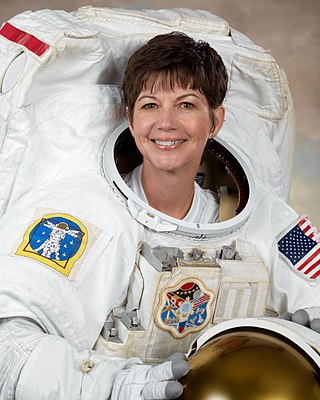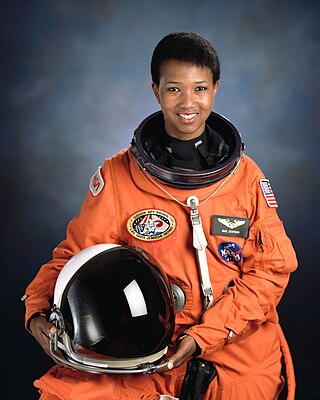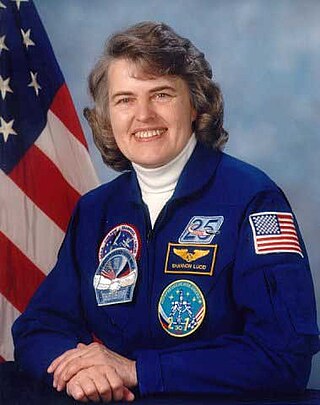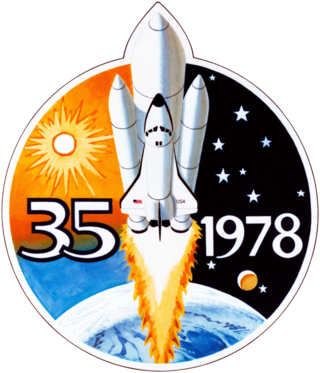Women in space have flown and worked in outer space.
Women in space may also refer to:

An astronaut is a person trained, equipped, and deployed by a human spaceflight program to serve as a commander or crew member aboard a spacecraft. Although generally reserved for professional space travelers, the term is sometimes applied to anyone who travels into space, including scientists, politicians, journalists, and tourists.

Catherine Grace "Cady" Coleman is an American chemist, an engineer, a former United States Air Force colonel, and a retired NASA astronaut. She is a veteran of two Space Shuttle missions, and departed the International Space Station on May 23, 2011, as a crew member of Expedition 27 after logging 159 days in space.

Sally Kristen Ride was an American astronaut and physicist. Born in Los Angeles, she joined NASA in 1978, and in 1983 became the first American woman and the third woman to fly in space, after cosmonauts Valentina Tereshkova in 1963 and Svetlana Savitskaya in 1982. She was the youngest American astronaut to have flown in space, having done so at the age of 32.

Kalpana Chawla was an Indian-born American astronaut and aerospace engineer who was the first woman of Indian origin to go to space. She first flew on Space Shuttle Columbia in 1997 as a mission specialist and primary robotic arm operator.

Mae Carol Jemison is an American engineer, physician, and former NASA astronaut. She became the first African-American woman to travel into space when she served as a mission specialist aboard the Space Shuttle Endeavour in 1992. Jemison joined NASA's astronaut corps in 1987 and was selected to serve for the STS-47 mission, during which the Endeavour orbited the Earth for nearly eight days on September 12–20, 1992.

Peggy Annette Whitson is an American biochemistry researcher, retired NASA astronaut, former NASA Chief Astronaut, and an active Axiom Space astronaut. Whitson has a total of 665 days in space, more than any other American or woman.

Shannon Wells Lucid is an American biochemist and retired NASA astronaut. She has flown in space five times, including a prolonged mission aboard the Russian space station Mir in 1996, and is the only American woman to have stayed on Mir. From 1996 to 2007, Lucid held the record for the longest duration spent in space by an American and by a woman. She was awarded the Congressional Space Medal of Honor in December 1996, making her the tenth person and the first woman to be accorded the honor.
Nassa may refer to:
Major Tom is a persona of David Bowie's, referenced in songs "Space Oddity", "Ashes to Ashes", "Hallo Spaceboy", and "Blackstar." Bowie's own interpretation of the character evolved throughout his career. "Space Oddity" (1969) depicts an astronaut who casually slips the bonds of the world to journey beyond the stars. In the song "Ashes to Ashes" (1980), Bowie reinterprets Major Tom as an oblique autobiographical symbol for himself. Major Tom is described as a "junkie, strung out in heaven's high, hitting an all-time low". This lyric was interpreted as a play on the title of Bowie's album Low (1977), which was inspired by the withdrawal symptoms he suffered while undergoing treatment for drug addiction. Additionally, the choked and self-recriminating tone used in the lyrics "Time and again I tell myself I'll stay clean tonight" reinforces an autobiographical and retrospective interpretation. A short time later, there is another reversal of Major Tom's original withdrawal, turning 'outwards' or towards space.

NASA Astronaut Group 2, also known as the Next Nine and the New Nine, was the second group of astronauts selected by the National Aeronautics and Space Administration (NASA). Their selection was announced on September 17, 1962. The group augmented the Mercury Seven. President John F. Kennedy had announced Project Apollo, on May 25, 1961, with the ambitious goal of putting a man on the Moon by the end of the decade, and more astronauts were required to fly the two-man Gemini spacecraft and three-man Apollo spacecraft then under development. The Mercury Seven had been selected to accomplish the simpler task of orbital flight, but the new challenges of space rendezvous and lunar landing led to the selection of candidates with advanced engineering degrees as well as test pilot experience.

The Mercury 13 were thirteen American women who took part in a privately funded program run by William Randolph Lovelace II aiming to test and screen women for spaceflight. The participants—First Lady Astronaut Trainees as Jerrie Cobb called them—successfully underwent the same physiological screening tests as had the astronauts selected by NASA on April 9, 1959, for Project Mercury. While Lovelace called the project Woman in Space Program, the thirteen women became later known as the Mercury 13—a term coined in 1995 by Hollywood producer James Cross as a comparison to the Mercury Seven astronauts. The Mercury 13 women were not part of NASA's official astronaut program, never flew in space as part of a NASA mission, and never met as a whole group.

Karen LuJean Nyberg is an American mechanical engineer and retired NASA astronaut. Nyberg became the 50th woman in space on her first mission in 2008.

Katherine Megan McArthur is an American oceanographer, engineer, and NASA astronaut. She has served as a Capsule Communicator (CAPCOM) for both the Space Shuttle and International Space Station (ISS). Megan McArthur has flown one Space Shuttle mission, STS-125 and one SpaceX mission, SpaceX Crew-2 on Crew Dragon Endeavour. She is known as the last person to be hands on with the Hubble Space Telescope via the Canadarm. McArthur has served in a number of positions including working in the Shuttle Avionics Laboratory (SAIL). She is married to fellow astronaut Robert L. Behnken.

NASA Astronaut Group 8 was a group of 35 astronauts announced on January 16, 1978. It was the first NASA selection since Group 6 in 1967, and was the largest group to that date. The class was the first to include female and minority astronauts; of the 35 selected, six were women, one of them being Jewish American, three were African American, and one was Asian American. Due to the long delay between the last Apollo lunar mission in 1972 and the first flight of the Space Shuttle in 1981, few astronauts from the older groups remained, and they were outnumbered by the newcomers, who became known as the Thirty-Five New Guys (TFNG). Since then, a new group of candidates has been selected roughly every two years.
Flat or flats may refer to:

Women have flown and worked in outer space since almost the beginning of human spaceflight. A considerable number of women from a range of countries have worked in space, though overall women are still significantly less often chosen to go to space than men, and by June, 2020 constitute only 12% of all astronauts who have been to space. Yet, the proportion of women among space travelers is increasing substantially over time.
Spacewoman or space woman may refer to:
Lady Astronaut may refer to: